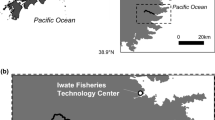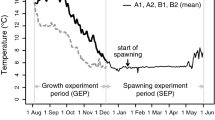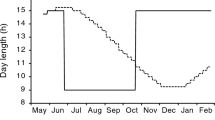Abstract
Increased growth during winter increased the incidence of age 1+ Salmo salar smolts in spring. High condition factor in spring and good growth in summer was associated with a high incidence of sexually mature males in autumn. In two experiments, groups (n=160–237 per group) of individually identified parr, either ungraded (lower and upper modal groups: LMG, UMG) or size-graded (LMG only), were reared at either 10, 6 or 3 °C overwinter (Nov to May). At 10 °C, up to 51% of parr originally in the LMG became smolts in spring at age 1+. In contrast, at either 6 or 3 °C (control), < 6% of LMG parr became smolts. The probability of being recruited into the UMG overwinter was positively related to initial body size, and was increased by size-grading. Smolt recruitment was two-fold higher among females compared to males; a proportion of males by age 0+ had already opted to mature at age 1+ rather than smolt at age 1+. In contrast, smolting at age 1+ was not inhibited in males previously mature at age 0+. During summer (May to Nov), all experimental groups were reared at ambient temperature, each subdivided between fresh water (max 21 °C) or seawater (max 15 °C). Good growth in seawater of winter recruits into the UMG confirmed they had completed smolting. Mortality in seawater among parr was 41–83%, and among smolts was 10–22%. Specific growth rate during summer was inversely related to winter rearing temperature. The incidence of sexual maturity in autumn at age 1+ among male parr was positively related to winter rearing temperature, fork length and condition factor in May, but there was large variation among individuals with respect to body size and maturity. Summer rearing in seawater reduced growth and the incidence of maturation. Parr and post-smolt maturity was 84–99% and 100% in fresh water respectively, 21–58% and 0% in seawater.
Similar content being viewed by others
References cited
Berglund, I. 1992. Growth and early sexual maturation in Baltic salmon (Salmo salar) parr. Can. J. Zool. 70: 205–211.
Berglund, I. 1995. Effects of size and spring growth on sexual maturation in 1+ Atlantic salmon (Salmo salar) male parr: interactions with smoltification. Can. J. Fish. Aquat. Sci. 52: 2682–2694.
Berglund, I., L.P. Hansen, H. Lundqvist, B. Jonsson, T. Eriksson, J.E. Thorpe & L.-O. Eriksson. 1991. Effects of elevated winter temperature on seawater adaptability, sexual rematuration, and downstream migratory behaviour in mature male Atlantic salmon parr (Salmo salar). Can. J. Fish. Aquat. Sci. 48: 1041–1047.
Berglund, I., H. Lundqvist & H. Fängstram. 1994. Downstream migration of immature salmon (Salmo salar) smolts blocked by implantation of the androgen 11-ketoandrostenedione. Aquaculture 121: 269–276.
Bohlin, T., C. Dellefors & U. Faremo. 1994. Probability of first sexual maturation of male parr in wild sea-run brown trout (Salmo trutta) depends on condition factor 1 yr in advance. Can. J. Fish. Aquat. Sci. 51: 1920–1926.
Bolger, T. & P.L. Connolly. 1989. The selection of suitable indices for the measurement and analysis of fish condition. J. Fish Biol. 34: 171–182.
Cone, R.S. 1989. The need to reconsider the use of condition indices in fishery science. Trans. Amer. Fish. Soc. 118: 510–514.
Crim, L.W. & D.M. Evans. 1978. Seasonal levels of pituitary and plasma gonadotropin in male and female Atlantic salmon parr. Can. J. Zool. 56: 1550–1555.
Duston, J. 1994. Effect of salinity on survival and growth of Atlantic salmon (Salmo salar) parr and smolts. Aquaculture 121: 115–124.
Duston, J. 1995. A light-reflectance meter to quantify silvering during smolting in Atlantic salmon. J. Fish Biol. 46: 912–914.
Duston, J. & R.L. Saunders. 1992. Effect of 6-, 12-, and 18-month photoperiod cycles on smolting and sexual maturation in juvenile Atlantic salmon (Salmo salar). Can. J. Fish. Aquat. Sci. 49: 2273–2280.
Duston, J. & R.L. Saunders. 1995. Increased winter temperature did not affect completion of smolting in Atlantic salmon. Aquaculture International 3: 196–204.
Elliott, J.M. 1991. Tolerance and resistance to thermal stress in juvenile Atlantic salmon, Salmo salar. Freshwater Biol. 25: 61–70.
Elson, P.F. 1957. The importance of size in the change from parr to smolt in Atlantic salmon. Can. Fish. Cult. 21: 1–6.
Eriksson, T., L.O. Eriksson & H. Lundqvist. 1987. Adaptive flexibility in life history tactics of mature male Baltic salmon parr in relation to body size and environment. Amer. Fish. Soc. Symp. 1: 236–243.
Gunnes, K. 1976. Effect of size grading young Atlantic salmon (Salmo salar) on subsequent growth. Aquaculture 9: 381–386.
Herbinger, C.M. & G.W. Friars. 1992. Effects of winter temperature and feeding regime on the rate of early maturation in Atlantic salmon (Salmo salar) male parr. Aquaculture 101: 147–162.
Hoar, W.S. 1988. The physiology of smolting salmonids. pp. 275–343. In: W.S. Hoar & D.J. Randall (ed.) Fish Physiology, Vol. 11B, Academic Press, New York.
Hutchings, J.A. & R.A. Myers. 1994. The evolution of alternative mating strategies in variable environments. Evol. Ecol. 8: 256–268.
Johnston, C.E. & R.L. Saunders. 1981. Parr-smolt transformation of yearling Atlantic salmon (Salmo salar) at several rearing temperatures. Can. J. Fish. Aquat. Sci. 38: 1189–1198.
Kristinsson, J.B., R.L. Saunders & A.J. Wiggs. 1985. Growth dynamics during the development of bimodal length-frequency distribution in juvenile Atlantic salmon (Salmo salar L.). Aquaculture 45: 1–20.
Lundqvist, H. & G. Fridberg. 1982. Sexual maturation versus immaturity: different tactics with adaptive values in Baltic salmon (Salmo salar L.) male smolts. Can. J. Zool. 60: 1822–1827.
Metcalfe, N.B. & J.E. Thorpe. 1990. Determinants of geographic variation in the age of seaward-migrating salmon, Salmo salar. J. Anim. Ecol. 59: 135–145.
Metcalfe, N.B., F.A. Huntingford & J.E. Thorpe. 1988. Feeding intensity, growth rates, and the establishment of life-history patterns in juvenile Atlantic salmon Salmo salar. J. Anim. Ecol. 57: 463–474.
Myers, R.A. 1984. Demographic consequences of precocious maturation of Atlantic salmon (Salmo salar). Can. J. Fish. Aquat. Sci. 41: 1349–1353.
Nicieza, A.G., F. Brana & M.M. Toledo. 1991. Development of length-bimodality and smolting in wild stocks of Atlantic salmon, Salmo salar L., under different growth conditions. J. Fish Biol. 38: 509–523.
Osterdahl, L. 1969. The smolt run of a small Swedish river. pp. 205–215. In: T.G. Northcote (ed.) Salmon and Trout in Streams, H.R. MacMillan Lectures in Fisheries, Univ. British Columbia, Vancouver.
Prentice, E.F., T.A. Flagg, C.S. McCutcheon, D.F. Brastow & C.A. McCutcheon. 1990. Equipment, methods, and automated data-entry station for PIT tagging. Amer. Fish. Soc. Symp. 7: 335–340.
Prosser, C.L. 1986. Adaptational biology: molecules to organisms. J. Wiley and Sons, New York. 321 pp.
Rowe, D.K. & J.E. Thorpe. 1990a. Suppression of maturation in male Atlantic salmon (Salmo salar L.) parr by reduction in feeding and growth during spring months. Aquaculture 86: 291–313.
Rowe, D.K. & J.E. Thorpe. 1990b. Differences in growth between maturing and non-maturing male Atlantic salmon, Salmo salar L., parr. J. Fish Biol. 36: 643–658.
Saunders, R.L. & C.B. Schom. 1985. Importance of the variation in life history parameters of Atlantic salmon (Salmo salar). Can. J. Fish. Aquat. Sci. 42: 615–618.
Saunders, R.L., E.B. Henderson & B.D. Glebe. 1982. Precocious sexual maturation and smoltification in male Atlantic salmon (Salmo salar). Aquaculture 28: 211–229.
Saunders, R.L., P.R. Harmon & D.E. Knox. 1994a. Smolt development and subsequent sexual maturity in previously mature male Atlantic salmon (Salmo salar). Aquaculture 121: 79–93.
Saunders, R.L., J. Duston & T.J. Benfey. 1994b. Environmental and biological factors affecting growth dynamics in relation to smolting of Atlantic salmon, Salmo salar L. Aquacult. Fish. Manage. 25: 9–20.
Scott, A.P. & J.P. Sumpter. 1989. Seasonal variations in testicular germ cell stages and in plasma concentrations of sex steroids in male rainbow trout (Salmo gairdneri) maturing at 2 years old. Gen. Comp. Endocr. 73: 46–58.
Silverstein, J.T. & H. Shimma. 1994. Effect of restricted feeding on early maturation in female and male amago salmon, Oncorhynchus masou ishikawae. J. Fish Biol. 45: 1133–1135.
Skilbrei, O.T. 1991. Importance of threshold length and photoperiod for the development of bimodal length-frequency distribution in Atlantic salmon (Salmo salar). Can. J. Fish. Aquat. Sci. 48: 2163–2172.
Sokal, R.R. & F.J. Rohlf. 1969. Biometry. W.H. Freeman, San Francisco. 776 pp.
Sutterlin, A.M., P. Harmon & B. Young. 1978. Precocious sexual maturation in Atlantic salmon (Salmo salar) postsmolts reared in a seawater impoundment. J. Fish. Res. Board Can. 35: 1269–1272.
Thorpe, J.E. 1986. Age at first maturity in Atlantic salmon, Salmo salar: freshwater period influences and conflicts with smolting. pp. 7–14. In: D.J. Meerburg (ed.) Salmonid Age at Maturity, Can. Spec. Publ. Fish. Aquat. Sci. 89.
Thorpe, J.E., R.I.G. Morgan, E.M. Ottaway & M.S. Miles. 1980. Time of divergence of growth groups between potential 1 + and 2 + smolts among sibling Atlantic salmon. J. Fish Biol. 17: 13–21.
Thorpe, J.E., R.I.G. Morgan, C. Talbot & M.S. Miles. 1983. Inheritance of developmental rates in Atlantic salmon, Salmo salar L. Aquaculture 33: 119–128.
Thorpe, J.E., C. Talbot, M.S. Miles & D.S. Keay. 1990. Control of maturation in cultured Atlantic salmon, Salmo salar, in pumped seawater tanks, by restricting food intake. Aquaculture 86: 315–326.
Whitesel, T.A. 1993. Comparison of juvenile Atlantic salmon (Salmo salar) reared in a hatchery and introduced into a stream: a two-size-threshold model for smoltification. Can. Spec. Publ. Fish. Aquat. Sci. 118: 239–247.
Author information
Authors and Affiliations
Rights and permissions
About this article
Cite this article
Duston, J., Saunders, R.L. Life histories of Atlantic salmon altered by winter temperature and summer rearing in fresh- or sea-water. Environmental Biology of Fishes 50, 149–166 (1997). https://doi.org/10.1023/A:1007373016067
Issue Date:
DOI: https://doi.org/10.1023/A:1007373016067




